Jo Sik (Nam-myung)
(1501 - 1572)
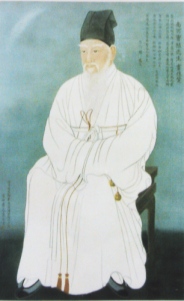 Jo Sik (pen name Nam-myung) was a famous Neo-Confucian scholar
of the Chosun dynasty and part of the Mountain and Forest school.
Jo Sik (pen name Nam-myung) was a famous Neo-Confucian scholar
of the Chosun dynasty and part of the Mountain and Forest school.He spent the last 10 years of his life in and around Sicheon (Doksan). In fact it was he who named the area Doksan, (approximately "virtuous mountain").
He devoted his whole life to studying and teaching and although he was offered powerful government positions
by the King he refused them all.
Despite that he was not afraid, at great personal risk, to critize the King when injustices
were being committed. He was also a proponent of both democracy and institutional reforms.
He strongly believed that it was not enough just to talk about ethics and morality,
he critized a number of his contemporaries for doing just that, but they should be carried out in practice every day.
As with many others their basic philosophy followed Chu Hsi, an early major influence on Korean Neo-Confucianism. However, they they all tended to developed their own thinking, as exemplified by Jo Sik's particular doctrine of Kyong (moral purity) and Eui (right conduct). This contributed to the creation of the Sil-Hak(Practical Sciences)in the late Chosun period.
More information on Chu Hsi and Neo Confucianism in Korea can be found here.
During the invasion by the Japanese at the end of the 16th century a number of Jo Sik's students played a leading role as commanders of the resistance movement. One of the most famous , Kwak Chae U, was also called the "Red Robe" general.
Jo Sik was actually born in the small village of Samga in the Hapchon county of Kyongsangnam-do. But it is here in Sicheon that the family ancestral shrine (gamyo), housing memorial tablets of Jo Sik and his two wives Lady Junggyung and Lady Suk, is located.
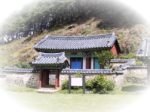
The actual tomb site is a short walk from here.
On the anniversaries of the deaths of the Master and his wives, as well as on the lunar new year,the autumn festival (August 15 according to the lunar calendar) as well as Korea's Independance Day and the winter solstice, descendants gather here to perform memorial rites.
More information (Korean only) can be found on the Institute of Nam-Myung Studies website.
Deokcheon Seowon

A Seowon was a privately run neo-Confucian academy,
usually dedicated to a famous scholar whose life the students wanted to emulate.
This seowon was built in honour of Nam-myung (Jo Sik) four years after his death.
It was built on the site of a thatched cottage where Jo Sik's disciples had met to hold discussions with their mentor.
At the end of King Seojo's (1567-1608) rule more than 100 seowons existed in Korea.
The seowon was burned down during the Japanese invasion at the end of the 16th Century and reconstructed in 1602.
It was formally given the title Deokcheon Seowon in 1609 by King Gwanghaegun.
By the middle of the 19th century seowons had become so powerful that they wielded immense economic power,by virtue of their ownership of large estates, many slaves and excemption from taxes. Added to this was the tremendous political power they had over the countryside due in no small part to government free control .This was so seriously damaging the country that during the period of mid-1860's to the mid-1870's the then King ordered all students to be removed and the seowons to be closed, with the result that only few dozen remained.
Deokcheon Seowon was renovated several times before being burned to the ground in 1877. It was only restored in the early part of the 20th century.
The layout of the complex, though smaller than the original, follows the classic design.
A central hall with separate buildings either side to house the students, with a ceremonial hall behind.
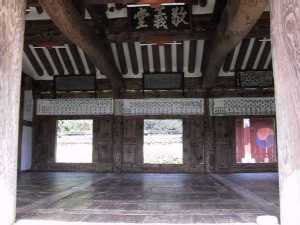
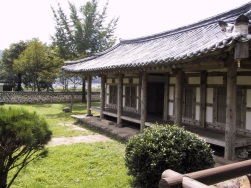
The main hall or Gyeonggeuidang (Hall of Reverance) was used for studies and discussions.
To the rear is a building used to hold ritual ceremonies.
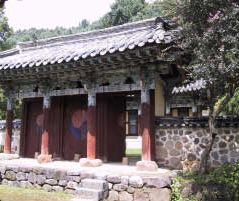

These ceremonies are held in conjunction with the festivities held in honour of Nam-myung on the 18th August and at other times throughout the year.
Approximately 5 seowons can still be found in Sancheong County.
Excellent descriptions and photographs of other seowons in Korea can be found at http://www.orientalarchitecture.com/ and clicking on S.Korea. `
Sancheon Jae
Nam-myung Song Saeng Munjip Chaekpan
It was here that Jo Sik spent the last 10 years of his life. During that time he focused on teaching and writing.This site holds his collected works, carved onto wooden printing blocks.
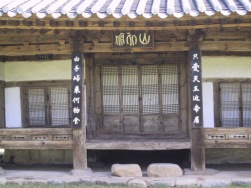
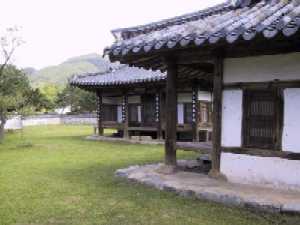
His writings, for various political and editorial reasons, went through three editions between 1632 and the late 19th century. The original collection was first published in the Haensa Buddist temple in 1602 but the printing blocks were destroyed by fire and republished in 1604.
The last of the three editions was supplemented with Jo Sik's biographical chronology and a further two works.
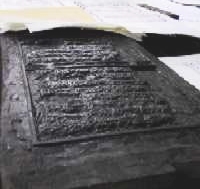
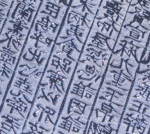 The current set of 185 woodblocks, plus numerous other books of his, have been preserved in their entirety and comprise six volumes. The blocks measure
approximately 40x20cm and can be seen during the Nam-myung festivals held at various times throughout the year.
The current set of 185 woodblocks, plus numerous other books of his, have been preserved in their entirety and comprise six volumes. The blocks measure
approximately 40x20cm and can be seen during the Nam-myung festivals held at various times throughout the year.Not only do the works convey the depth of his knowledge and wisdom but contain numerous historical facts regarding the region.


